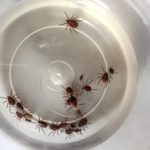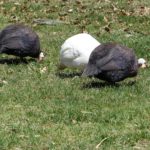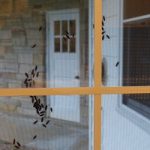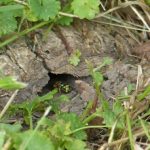by Winding Pathways | Jun 28, 2018 | Nature, Pests, Trees/Shrubs

Poison Ivy loves edges
This summer millions of Americans will have unhappy encounters with poison ivy. For most people, the result is a patch of itchy bumpy skin that goes away after a few days to a week or so. Unfortunate others will develop a serious reaction that includes severe itching and swelling.
The very best way to not get a case of poison ivy is to avoid the plant and its culprit – urushiol, an oil that causes the allergic reaction. It’s on the plant’s leaves, in the vines and the sap.
Avoiding urushiol is a surefire way of avoiding a poison ivy rash, but many people have trouble identifying the plant. Fortunately, poison ivy has a secret. Knowing it helps people avoid the plant.
Poison ivy is an amazingly adaptable, hardy and confusing plant. It can be a low growing ankle high sprig, a shoulder high shrub, or a vine winding up to the top of a tall tree. The old saying “Leaves of three, let them be” is only partially helpful in identifying the plant. Usually, it does have leaves in groups of three but many animals love dining on poison ivy and are immune to its ill effects. So, a rabbit or deer may have eaten a leaf, giving the plant leaves of two! And many nonpoisonous plants have leaves of three.
Enter the plant’s secret. Poison ivy is a plant of the edge. It’s rare in the middle of a sun-soaked prairie or in a deeply shaded forest. The plant almost always hugs the edge of a habitat, especially if it gets partial sunshine.

Birds drop seeds when they perch on campground posts.
We’ve seen poison ivy on the edges of:
- Lawns, including ours
- The ocean sand dunes
- Lakes, especially along trails
- Roads
- Trails anywhere
- Ballfields – the rough where balls sometimes go
- Picnic areas
- It especially seems to love life in state park campgrounds especially around the posts that mark a site number and the trees that shade a campground area and that kids love to hug!
So, to avoid poison ivy be especially cautious on the edge. Look carefully at edge plants and study photos of poison ivy in books and on the Internet. Avoid poison ivy when you can.
But, if you accidentally touch the plant or have been wading through likely habitat, get home soon, remove clothes carefully, avoiding touching the outsides of clothes where poison ivy sap may have touched, take a sudsy shower, toss the towels in the laundry, and odds are good that the oil will be soaped off before it creates an allergic reaction.
by Winding Pathways | May 17, 2018 | Bugs, Garden/Yard, Nature, Pests
Creepy Crawlers
Even before Lyme disease created a serious tick-borne health hazard no one wanted ticks crawling on them. We sure don’t want them at Winding Pathways and because our yard has tall grass, shrubs, and a woodland we have tick habitat.

Collection of ticks
A few years ago, Rich contracted Lyme Disease caused when a tick injected bacterium into him. Thanks to a wise physician and effective antibiotics he was cured, but it’s possible to get Lyme Disease again and again. We’re more cautious about avoiding ticks now.
Ticks of many species live throughout most of the United States. They’re common in brushy, grassy, and woodsy habitat but they also love living in yards. It’s possible for a tick to enjoy a human meal even if that person never leaves a mowed yard.
Natural Tick Predators
Although naturalized yards are sometimes good tick habitat they also attract tick predators that love to snack on the tiny invertebrates. Many small birds, including warblers, wrens, and brown creepers among them quickly convert any tick they find into lunch.
Possums Are Us!

Opossums groom themselves carefully.
A newly understood tick-lover is the common opossum. Many people consider this ancient marsupial a homely animal and would prefer to not have one in their yard, but they might want to rethink this. According to the Carey Institute, opossums are tick vacuum cleaners. As they walk through a yard ticks hitch a ride, thinking they will be able to burrow into the animal’s skin and feast on warm blood. The tick doesn’t realize that possums groom their fur often and comb out ticks. These are readily eaten by the always hungry mammal. Having an opossum in the neighborhood can reduce tick numbers.
Foxes and Coyotes
Small predators, like the fox, are also valuable in tick reduction. According to a study by Dr. Hofmeester, Foxes and coyotes eat mice that ticks feed on. Ticks need three meals before they can reproduce, so more foxes and coyotes can reduce the mouse population and thus, the tick population by “…breaking the cycle of infection.”
Life Cycle
Tick numbers are also associated with climate change and abundance of food. Dr. William H. Schlesinger in an April 2018 issue of Citizen Scientist wrote about the work of Rick Ostfeld with the Carey Institute. The occurrence of ticks one year relates to mice numbers the year before, which relates to food abundance in previous years. The chain of life! And, according to Ostfeld, white-tailed deer are less implicated, unlike initial beliefs, and turkeys also appear to help reduce tick numbers. That is great news for us at Winding Pathway because the wild turkeys pretty much take over our yard at times!
Gobbling Guineas

Guineas eat ticks.
A domestic bird that loves ticks is Guineas. They are tick lovers. They are African natives that have been domesticated. Elise Gallet de St Aurin, of Cheshire Moon Farms, told us the guineas that roam her farm near Atkins, Iowa, keep it clear of ticks. These attractive but loud animals roam widely, roost in trees, and eat all sorts of invertebrates, including ticks.
It’s impossible to buy or confine an opossum. But, guinea chicks can be ordered from Hoover’s Hatchery. Some people also enjoy eating guineas.
Repelling Ticks
A simple way to reduce odds that a tick will hitchhike on a person is to use repellents and chemicals that kill them. Any insect repellent containing DEET will repel ticks. Spray it heavily on the legs and arms and on clothing, especially pant legs, shoes, and socks. DEET doesn’t persist long and disappears after clothes are washed so it needs to be reapplied often.

Various forms of tick repellent.
A more permanent solution is to use a spray containing permethrin. This chemical actually kills the ticks. It lasts a long time, even through several wash cycles. It should not be applied to the skin. We spray it on our pants, socks, and shoes. One set of Permethrin-sprayed-pants remains hung in our cabin – not in the house – to put on when we are venturing in likely tick habitat.

Protect yourself with gaiters
Ticks usually access a person from down near the ground. They’re most likely to cling to pant legs or socks and then walk uphill on the skin. Tucking pants into socks makes life harder for these pesky animals, and we take it one step further. We bought a pair of tick gaiters from Forestry Suppliers, Inc. They cost about $11 and fit over shoes and pant legs, forming a tight seal.
Tick Checks
Doing a “tick check” is important. After being outside take a hot sudsy shower and check the body over for ticks. Fortunately, they usually wander around on the skin for several hours before burrowing in. A tick that has not penetrated the skin won’t spread disease and often is simply washed down the drain. Launder the clothes right away.
Ticks deserve respect. They can spread serious disease and they lurk where people often go. Don’t let a fear of ticks keep you inside. Go outside and play but take precautions to reduce the chances of catching a tick-borne illness.
by Winding Pathways | Mar 14, 2017 | Nature, Pests

All this winter box elder bugs have gathered on warm sunny sides of homes.
Lots of box elder bugs are traipsing through homes this winter to the consternation of human occupants.
This amazingly common and crafty insect is a true bug named for common box elder trees. You don’t have to have box elder trees nearby to “enjoy” visits by the bug. Maple and ash trees of several species make a suitable hosts. Since these trees are everywhere in suburbia it’s no wonder box elder bugs pester so many people. Box elder bugs make their living feeding on tree seeds and sap but they don’t pose a threat to their host. Unlike the pests of many other trees box elder bugs don’t kill trees.
Come fall, box elder bugs prepare for cold weather by tucking themselves into bark crevices to patiently wait out the cold. However, they would rather be warm and if a house is nearby they seem to sense that soon the furnace will be going and indoors is the best place to overwinter,.
Although they are fairly large insects box elder bugs can crawl through tiny cracks and holes. Often they swarm in the sun on the exterior of a house and some manage to find their way inside. Winter is spent idly exploring light fixtures, furniture, and walls.
They are not really a serious pest. Pesky might be a better way to describe them. Box elder bugs neither bite nor sting. They do sometimes crawl on people and pets. Perhaps their most disagreeable characteristics are pooping and emitting a disagreeable odor if they are crushed. It’s this bad odor that protects them from predators. Hardly anything will eat a box elder bug.
Want to rid the house of box elder bugs? The best defense is a caulking gun. Late each summer seal up cracks that allow them to squeeze into the house. Any found wandering around inside can be vacuumed up, and a shop vac can suck up hundreds sunning on the exterior. Dump them in soapy water and they’ll quickly drown. A hose can also knock them off an exterior wall. Insecticides kill them but perhaps insecticides create more problems than they solve. Some people report that spraying box elder bugs with soapy water also kills them.
Box elder bugs aren’t harmful, but they are pesky and goofy. Caulking up home cracks can encourage them to winter outdoors in trees, rather than inside with you.
#
by Winding Pathways | Feb 20, 2017 | Birds, Nature, Pests
A recent article in LIVING BIRD Magazine reported that cats kill more than 2.4 billion birds each year in the United States. Their numbers came from the book, CAT WARS, by Peter Marra and Chris Santella.
use cats are fascinating animals that are loved by 600 million people worldwide who keep one or more as pets. They’ve been part of the human experience since at least the dawn of agriculture. Descended from a species that remains wild in Saudi Arabia, Israel, and other Middle Eastern countries, cats were informally domesticated as early as 10,000 years ago. Probably the earliest semi tame cats were wild individuals who lived near cultivated fields and hunted mice and other pests. At some point people began taking them into their homes as pets.
House cats followed humans as they spread around the globe and today are common wherever people live. Unlike many domestic animals that long ago lost their ability to survive in the wild, cats often go wild. These “feral” animals have a high reproductive rate and can create a large wild population in a relatively short time. Often these colonies of feral cats prey on animals that have no defense against them.
Cats never lost their ability to hunt and continue to catch animals, especially mice and other small mammals. Unfortunately they are also effective bird predators. Cats kill more birds than collisions with buildings, power lines, and wind turbines combined. They pose a serious threat to some bird populations.
There is a simple way that cat lovers can enjoy their pet while reducing the impact of these fascinating animals on birds…….keep them indoors.
For more information:
Cat Wars: The Devastating Consequences of a Cuddly Killer. Princeton University Press.
The Cornell University Laboratory of Ornithology.
*Note: Winding Pathways is not paid by companies we feature.
by Winding Pathways | Aug 30, 2016 | Mammals, Nature, Pests
A long-ago children’s story began something like this, “There is a mouse in my house. It is a very nice mouse. It has a long, long tail and shiny eyes. It pops out of its hole and runs. My mother likes the mouse, but she says, ‘A mouse does not belong in a house.’”
Well, guess what, a sure sign that fall is approaching is “a mouse in the house.” These tiny mammals realize that shorter days and cooler temperatures beckon winter. Finding a safe warm place to live with an abundance of food helps them survive the tough season.
At Winding Pathways we expect mice to appear with the first cool weather in late August or September. Once in a while we have seen one scurrying across the floor, but more often we have found their tiny black droppings on counters. Sometimes we have heard them scurrying about an upstairs closet.
Two types of mice inhabit houses. Both gobble birdseed and will eat nearly anything people do. They capable of doing damage and possibly spreading disease.
The common house mouse is a gray mammal native to the Old World that is now found everywhere people live. They like houses, barns, garages, and sheds but are rarely found far from buildings and live indoors all year round.
Several species of native mice live outdoors most of the year but move inside each fall. These are normally called deer or field mice and are beautiful tiny mammals with shiny eyes and white feet.
They store food, while house mice don’t. Find a pile of sunflower seeds in a shoe and the culprit is a native mouse.
We love wildlife but don’t tolerate mice in the house. So, each fall we plan an eviction campaign.
Here’s how we reduce mouse problems at Winding Pathways:
- Tighten up cracks and holes. Every fall we arm ourselves with a caulking gun and can of expanding foam and inspect the house from the outside and inside. We fill in any likely entryway for mice, which can squeeze through tiny spaces. Caulking also helps keep insects and cold air out of the house.
- Set up a trap line. Old fashioned mouse traps efficiently catch and instantly kill mice if set properly. Here are some effective trapping tips:
- Buy many traps and set them all at once. Try to catch all or most mice in one night, rather than just setting a few traps.
- Bait traps with peanut butter and set them with the trigger side against the wall where mouse evidence is noticed. Mice tend to run along walls, rather than across the interior of a room, so trapping success is usually best near a wall.
- Set traps in tandem. Instead of just setting one trap here and there along a wall double or triple them up side by side, again with the trigger side facing the wall.
- We don’t use poison. It seems cruel and inhumane and poisoned mice tend to die in inaccessible places and stink to high heavens.
- Encourage predators. We don’t have a cat but encourage raptors to visit our yard. They work year round reducing rodent numbers.
- Mice are encouraged by food. We keep all food in sealed metal containers or in the refrigerator and wipe up any spilled food. Wild bird and pet foods are loved by mice. Keep them in a metal can with a tight lid and dump out the dog or cat’s food dish in the evening so there’s nothing for nocturnal mice to eat.
Mice are fascinating animals that play an important role in nature, but they belong outside. It’s probably not possible to entirely eliminate them from a house but simple techniques will encourage them to stay outdoors.
by Winding Pathways | Aug 3, 2016 | Bugs, Nature, Pests

Yellow Jackets often create a nest in the ground under bark.
As Marion was looking out the window recently she saw Rich abandon the lawn mower and race across the yard swatting and jumping as he ran. What was going on?
He’d pushed the mower up close to wood mulch around a tree and disturbed a Yellow Jacket nest. They boiled out of their underground home and attacked. Rich was stung five times as they chased him across the yard.
Many people have unpleasant encounters with this aggressive insect every year, especially in late summer. Their stings are painful and it’s a rare and fortunate person who only gets stung once. Multiple stings are normal. First, get away from the nest and alert everyone else around about the nest. Then, put ice on the stings to keep swelling down. Watch for and treat more serious allergic reactions.
The life history of Yellow Jackets is interesting. Many species live in the United States. Some, like the German yellow jacket, are exotic while others are native. Most have the familiar yellow and black pattern, although a few species may be black and white. Only the queen overwinters, and in spring she makes a nest that’s usually underground but can be found in other locations. She’s an egg laying machine. By late summer the colony can have thousands of members.
This insect is generally beneficial. Adults eat a wide array of fruits, meat, sweets and insects but normally they feed their larvae insect parts. Although they consume pesky insects, they often forage in trash cans and they love picnics. A definite problem because there is nothing beneficial about being stung many times. The experience can be traumatic to a child.
Yellow jackets don’t go out of their way to sting, but they do readily attack anything they believe threatens their home. Generally they won’t attack a person walking quietly in the area. But anyone who disturbs the leaves or sticks near their entry hole will be chased by dozens of yellow jackets as they boil out of their nest and attack.
If the nest is in a place with much human traffic, it is prudent to destroy it. That requires pinpointing the entry. To find it, carefully approach the area where the nest is suspected. Look for a small hole, often under a piece of wood, with insects coming and going. Avoid making noise or disturbing leaves, mulch, or wood. A pair of close focusing binoculars can aid in the search. Once the entry is located follow these steps:
- Wait until after dark when all insects are down in the nest.
- Approach the entry hole with a flashlight, a spray can of wasp killer, and a piece of carpet.
- Spray the poison down the hole and cover it with the carpet to keep fumes and insects inside.
Remember to only destroy a nest if the insects pose a stinging threat. Otherwise leave it alone for these beneficial, although cranky insects to live.
A side note is that several colleges and universities like Georgia Tech and Black Hills State University sport the Yellow Jackets as their mascot. Appropriate Buzz and Sting!









